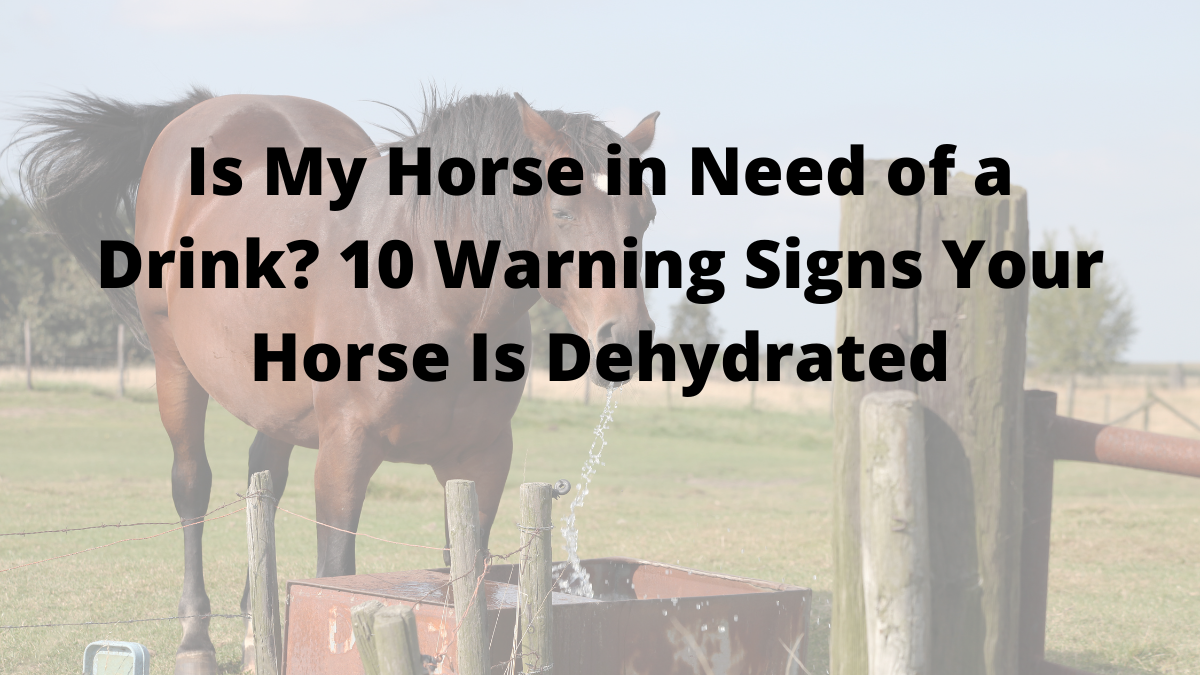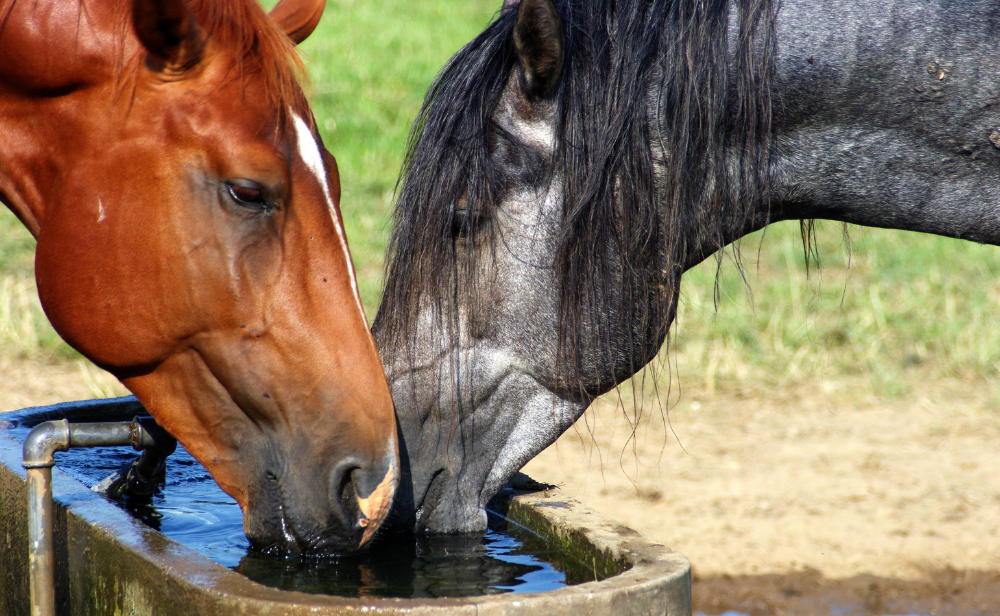Is My Horse in Need of a Drink? 10 Warning Signs Your Horse Is Dehydrated


Something was clearly wrong when my granddaughter and I approached her horse’s paddock, and he stood there, unmoving. My immediate concern was that he might be dehydrated.
Dehydrated horses are those that have been severely deprived of water and minerals. Lack of energy, red mucous membranes and skin swelling are all signs of dehydration. Other symptoms to watch out for include nausea, vomiting, dizziness, and fever.
Dehydration in horses is a life-threatening situation that needs to be addressed promptly. Equine dehydration can manifest in various ways, some subtle and others were more obvious.
When horses lose too much fluid, they get dehydrated.
If the horse loses more fluid than it takes in due to dehydration, it will not be able to function correctly. The horse is dehydrated if the deficit is not rectified.
Animals, like people, are susceptible to dehydration. Horses, on the other hand, are particularly vulnerable to this complication. Heat exhaustion is by far the most common cause of horse dehydration.
Sweat and respiration help horses dissipate heat very effectively, which is excellent for keeping them cool but also reduces the amount of water and electrolytes their organs require.
In a one-mile race, racehorses can lose 5% of their body weight. Temperature, humidity, and race length affect the quantity of fluid and electrolyte loss.
Trainers stress pre- and post-race hydration because horses lose so much fluid during a race that they risk dehydrating.
Dehydration in horses can also be caused by spells of severe diarrhoea and fever, as well as by a lack of clean water, medications, and hot weather. Water and electrolytes are usually enough to bring animals back to health in favourable situations of dehydration.
Horses show signs of dehydration.
Dehydration in horses manifests itself in a variety of ways. A veterinarian should be contacted immediately if you suspect your horse of becoming dehydrated.
Equine dehydration can manifest in a variety of ways.
Mucous membranes seem red.
Pink gums indicate that a horse is healthy and well-hydrated. Dehydration, anaemia, and illness can all lead to deviations from the norm. The horse’s mucous membranes will appear pale as a sign of dehydration.
It’s easy to tell if a horse is healthy by looking at its mucous membranes. The gums and the inside of the nostrils are lined with these tissues. These mucous membranes are nourished with blood and secrete mucus to keep themselves moist and protected.
Capillary refill time tests are a quick and straightforward approach to determining whether or not your horse has healthy gums. Your horse’s gums should “pink up” after one to two seconds of you applying pressure and then releasing it.
You may tell your horse is dehydrated if the pressure site doesn’t become pink after being pressed twice. Also, please notice how much saliva is dripping from his gums. Another sign that a horse is dehydrated is that he has a dry mouth.
Colour changes in the horse’s gums that indicate dehydration include reddening the tissue where it meets teeth and a paler appearance above the teeth. Dehydration causes the mucous membranes to become increasingly lighter, then blue and finally purplish as the condition worsens.
The longer the capillary refill time, the darker the colour. The colour of a horse’s gums can vary from time to time. Septic or endotoxin shock occurs when an animal’s hydration drops to these levels.
Lethargy
A horse’s lethargy can indicate dehydration, but it can also be a sign of an equine illness. Some of the most common early symptoms of Swamp Fever, Potomac Horse Fever, and other diseases are lethargy and diarrhoea.
After the vigorous activity, if your horse seems quieter than usual, it may be showing early indications of dehydration. Preventative measures should be taken immediately, and electrolytes should be given to your horse. Preventing dehydration is easier than combating it later on.
The condition can cause shock, long-term disability, and even death if neglected. The likelihood of recovery is significantly boosted if the disease is diagnosed and treated quickly.
If you detect a sudden shift in your horse’s behaviour, it’s generally caused by an underlying physical ailment. We’ve all had a lazy horse.
One telltale sign of a sluggish horse is its tendency to stay motionless in the corner of its stall or pasture, not even looking around.
The skin tenting
The “skin tent” test is a simple method used by horsemen to examine the hydration of their horses. The water content and elasticity of normal skin tissue are both high.
A horse’s skin tissues become “sticky” and less likely to return to their normal state after pinching after it has been dehydrated. This is known as “skin tenting,” which is done by first squeezing the horse’s skin at its shoulder and then pulling it upwards into a tent-like shape.
The skin of an average horse should flatten out within one second of you releasing it. Horse skin that takes longer than four seconds to recover to average indicates severe dehydration and requires quick assistance.
This simple tent test doesn’t accurately measure a horse’s hydration, but it is a helpful tool for briefly assessing a horse. Owners familiar with their horse’s skin sensitivity to the test in a normal state are the best people to use it.
Whether or not you’re sweating
Horses need to be replenished with fluids after a workout to avoid dehydration. When the skin temperature rises, blood vessels dilate, and blood flow increases, the body produces sweat as a natural response.
When exercising in hot, humid conditions, the amount of sweat and fluid loss increases. To ensure the appropriate functioning of the heart, muscles, brain, and kidneys, competitive horses working for long durations must be adequately hydrated.
During a hot, humid day, the sweat glands produce more fluid on the skin surface. In times of physical exertion, the adrenal glands help out with this process. However, this is just a broad summary of the procedure…
Excessive fluids are expelled from a horse’s body as sweat when it is under stress. Dehydration can occur as a result of excessive sweating.
Horses suffering from anhidrosis due to prolonged dehydration are at risk. In both people and horses, anhidrosis is a lack of sweating. Chronic dehydration, genetics, and environmental variables all have a role in the onset of the disease.
There was something that caused the sweat glands to stop working in a horse which was suffering from anhidrosis (dry skin). The disease is difficult to reverse and might be long-lasting. Keeping your horse hydrated could be all it takes to prevent the condition from developing.
Eyes that are arid and lifeless
Eyelids are a good measure of a horse’s overall hydration state. The eyes of a dehydrated horse may appear dull and lifeless. Horses have mucous membranes in their eyes.
The tear ducts secrete viscous mucus to keep the eyes wet and protected under normal circumstances. A horse’s eyes appear dry and dull when they are under the influence of excessive dehydration. When a horse is under-hydrated, its eyes may appear to be sunken into its head.
Appetite waning
If you discover that your horse isn’t interested in eating, it’s probably because he has a physical problem. Dehydration is one of the conditions that cause a horse to cease eating.
When a horse is dehydrated, it may lose its appetite because it feels ill. Colitis or digestive pain could also result from a lack of adequate fluids and electrolytes in the animal.
A rapid heartbeat
They generally demonstrate a fast heart rate when their bodies are dehydrated and lacking electrolytes. The resting heart rate of a healthy horse is typically between 36 and 42 beats per minute.
Because of the vast range of average equine heart rates, horse owners should have a general notion of their horse’s usual resting heart rate. Moderate can mean something outrageous to a horse.
Heart rates exceeding 60 beats per minute during rest may indicate dehydration. When endurance racehorse becomes dehydrated, their heart rates can soar to dangerously high levels.
Water and electrolytes can immediately restore a fast heart rate, a warning indication of fluid depletion.
Fever
Dehydration can cause fever, which is often mistaken for an infection. Fever-like symptoms can occur when a horse’s body loses control due to a fluid shortage.
The average body temperature of a horse is from 98 to 101 degrees Fahrenheit. However, their temperature varies throughout the day. As the day progresses, a horse’s body temperature rises, unlike in the morning.
Fever can be a sign of dehydration, or it might cause it. An illness causes a horse to sweat excessively, which can lead to dehydration if the fluids are not replaced. Rectal thermometers can be used to take your horse’s temperature, and it is recommended that you do so at least once a month to establish a baseline for the entire herd.
Toxic snot
The colour of a healthy horse’s urine is yellow or straw-coloured and may be hazy, bubbly, and a little darker or lighter. You know something’s wrong if it becomes brown; dehydration is the most likely cause.
When a horse’s pee is clear, it shows that it is adequately hydrated, but black urine suggests it is dehydrated.
Dehydration causes the horse’s body to lose a significant amount of water, resulting in the kidneys beginning to retain moisture. As a result, less water is excreted in the urine, making it darker and more concentrated.
A horse’s faeces can also tell you if it’s well-hydrated by its moisture content. The faeces of animals must include some water. You can test this by stomping on your horse’s manure and checking for water.
Irritability or disorientation
Maintaining healthy blood flow is one of the most important aspects of good health. Dehydration causes dizziness and disorientation in horses because of a drop in blood volume, blood pressure, and a lack of oxygen to the brain.
Detecting dehydration in a horse
To identify if your horse is dehydrated, you must conduct a complecomplete good. Despite what you may think, a thirsty horse isn’t necessarily an indication of dehydration.
Dehydrated animals may refuse to drink. Preventative measures and increased water consumption before and during hot weather are crucial to avoid dehydration.
Dehydration treatments
Precautions to take while riding
Overexertion can be avoided if you dismount and offer your horse drink and rest breaks when riding a long distance. Remove the horse’s saddle and any other tack, and give it a cold water bath if you can.
Your animal’s body should also be hosed down to remove any surplus water that may have accumulated. Left on the horse, warm water acts as an insulator, keeping the animal’s body temperature more comfortable.
Place the horse in a well-shaded place, and use a fan to assist it in chilling off after you’re done washing him. Cool-down is an excellent time to provide your horse with fresh water.
Intravenous therapy
Equine blood volume is dangerously low when it drops due to excessive fluid loss from dehydration. Blood volume is restored by veterinarians using saline solutions and other liquids.
Normal saline with potassium and calcium additions is a standard intravenous solution. Hypertonic saline solutions may be used in conjunction with plasma or blood to rehydrate a patient.
The water/salt equilibrium in an animal’s blood is replaced using hypertonic solutions. Hydration can take up to 80 litres over 12 hours for some extremely dehydrated horses.
Dehydration in horses can take a long time.
One gallon of water for every 100 pounds of body weight is how much a horse consumes daily. Depending on the environment, one’s level of fitness, and the amount of exercise, one’s water intake will change.
Fitness, environment, and effort all play a role in how long it takes a horse to become dehydrated due to a lack of water. Depriving a horse of water for two days usually results in the onset of dehydration symptoms in the animal.
Lacking water for three to four days can cause serious medical problems in horses, including organ failure and tissue damage that cannot be reversed.
Preventing the loss of water
Minerals such as chloride, salt, and potassium are lost by sweating horses and are essential to their health. Horses may not acquire enough electrolytes in their hay or feed; thus, electrolyte supplements are needed to replenish them.
To ensure that horses are getting adequate salt in their diet, salt supplements should be given to them regularly. Horses’ thirst is stimulated by salt, and their thirst disappears when salt is removed from their diet.
Keeping your horse well-hydrated can be as simple as:
Access a salt block, or give a daily salt dose of 1 tablespoon for 500 pounds of body weight.
Electrolyte supplements should be given to your horse if he has been sweating excessively. At least 12 grams of chloride, 6 grams of sodium, and 4 grams of potassium should be present in an ideal electrolyte supplement.
If you keep your horse in a stall, ensure proper ventilation and shade access. Horses needing extra hydration get crimped oats soaked in water, to which we add our nutrients.
Dehydration can be avoided by following these simple actions.
- It’s advised that you take an electrolyte supplement.
- Electrolyte supplement Farnam Apple Elite Electrolyte Supplement has no added sugar.
- Dehydration in Horses: The Final Say
- In extreme cases, dehydration can lead to physical harm or even death. A horse may require intravenous fluids and other treatments to avoid organ damage.
- The sooner you notice that your horse shows signs of dehydration, the better. It’s essential to keep your horse well-hydrated before you begin any exercise and to enable it to drink frequently throughout the day.
- Dehydration can result in a variety of health problems in horses, including colic, laminitis, organ failure, and even death.





